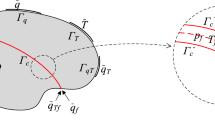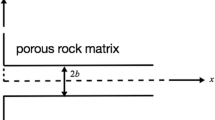Abstract
Quantification of mass and heat transport in fractured porous rocks is important to areas such as contaminant transport, storage and release in fractured rock aquifers, the migration and sorption of radioactive nuclides from waste depositories, and the characterization of engineered heat exchangers in the context of enhanced geothermal systems. The large difference between flow and transport characteristics in fractures and in the surrounding matrix rock means models of such systems are forced to make a number of simplifications. Analytical approaches assume a homogeneous system, numerical approaches address the scale at which a process is operating, but may lose individual important processes due to averaging considerations. Numerical stability criteria limit the contrasts possible in defining material properties. Here, a hybrid analytical–numerical method for transport modeling in fractured media is presented. This method combines a numerical model for flow and transport in a heterogeneous fracture and an analytical solution for matrix diffusion. By linking the two types of model, the advantages of both methods can be combined. The methodology as well as the mathematical background are developed, verified for simple geometries, and applied to fractures representing experimental field conditions in the Grimsel rock laboratory.
Similar content being viewed by others
References
Jacob, A.: Matrix diffusion for performance assessment—experimental evidence, modeling assumptions and open issues. Paul Scherrer Institute (2004)
Min, K., Rutqvist, J., Tsang, C.F., Jing, L.: Stress-dependent permeability of fractured rock masses: a numerical study. Int. J. Rock Mech. Min. Sci. 41, 1191–1210 (2004). doi:10.1016/j.ijrmms.2004.05.005
Taylor, L.W., Polard, D.D., Aydin, A.: Fluid flow in discrete joint sets: field observations and numerical simulations. J. Geophys. Res. 104(B12), 28983–29006 (1999). doi:10.1029/1999JB900179
Chen, C.Y., Horne, R.N., Fourar, M.: Experimental study of liquid–gas flow structure effects on relative permeabilities in a fracture. Water Resour. Res. 40(8), W083011–W0830115 (2004). doi:10.1029/2004WR003026
Zhang, Y., Liu, H., Zhou, Q., Finsterle, S.: Effects of diffusive property heterogeneity on effective matrix diffusion coefficient for fractured rock. Water Resour. Res. 42, 1–8 (2006)
Park, C.-H., Beyer, C., Bauer, S., Kolditz, O.: A study of preferential flow in heterogeneous media using random walk particle tracking. Geosciences J. 12(3), 285–297 (2008). doi:10.1007/s12303-008-0029-2
Berkowitz, B.: Characterizing flow and transport in fractured geological media: a review. Adv. Water Resour. 25, 861–884 (2002). doi:10.1016/S0309-1708(02)00042-8
Sanchez-Vila, X., Carrera, J.: On the striking similarity between the moments of breakthrough curves for a heterogeneous medium and a homogeneous medium with a matrix diffusion term. J. Hydrol. (Amst.) 294, 164–175 (2004). doi:10.1016/j.jhydrol.2003.12.046
Carrera, J., Sánchez-Vila, X., Benet, I., Medina, A., Galarza, G., Guimerà, J.: On matrix diffusion: formulations, solution methods and qualitative effects. Hydrogeol. J. 6, 178–190 (1998). doi:10.1007/s100400050143
Kosakowski, G.: Anomalous transport of colloids and solutes in a shear zone. J. Contam. Hydrol. 72, 23–46 (2004). doi:10.1016/j.jconhyd.2003.10.005
Grisak, G.E., Pickens, J.F.: An analytical solution for solute transport through fractured media with matrix diffusion. J. Hydrol. (Amst.) 52, 47–57 (1981). doi:10.1016/0022-1694(81)90095-0
Tang, D.H., Frind, E.O., Sudicky, E.A.: Contaminant transport in fractured porous media; analytical solution for a single fracture. Water Resour. Res. 17(3), 555–564 (1981). doi:10.1029/WR017i003p00555
Sudicky, E.A., Frind, E.O.: Contaminant transport in fractured porous media—analytical solutions for a system of parallel fractures. Water Resour. Res. 18(6), 1634–1642 (1982). doi:10.1029/WR018i006p01634
Barker, J.A.: Laplace transform solutions for solute transport in fissured aquifers. Adv. Water Resour. 5(2), 98–104 (1982). doi:10.1016/0309-1708(82)90051-3
Tidwell, V.C., Meigs, L.C., Christian-Frear, T., Boney, C.M.: Effects of spatially heterogeneous porosity on matrix diffusion as investigated by X-ray absorption imaging. J. Contam. Hydrol. 42, 285–302 (2000). doi:10.1016/S0169-7722(99)00087-X
Neuman, S.P.: Trends, prospects and challenges in quantifying flow and transport through fractured rocks. Hydrogeol. J. 13(1), 124–147 (2004). doi:10.1007/s10040-004-0397-2
Kolditz, O., Clauser, C.: Numerical simulation of flow and heat transfer in fractured crystalline rocks: application to the hot dry rock site in Rosemanowes (U.K.). Geothermics 27(1), 1–23 (1998). doi:10.1016/S0375-6505(97)00021-7
Kaiser, R., Rother, T., Kolditz, O., Zielke, W.: Automatic grid adaptation for modeling coupled flow and transport processes in fractured aquifers, Computational methods in water resources—Volume 1—Computational methods for subsurface flow and transport, 279–283 (2000)
Haefner, F., Boy, S.: Fast transport simulation with an adaptive grid refinement. Ground Water 41(2), 273–279 (2003). doi:10.1111/j.1745-6584.2003.tb02590.x
Pruess, K., Narasimhan, T.N.: A practical method for modeling fluid and heat flow in fractured porous media. Soc. Pet. Eng. J. 25(1), 14–26 (1985), February
Pruess, K.: Brief guide to the MINC-method for modeling flow and transport in fractured Media, Report LBL-32195, Earth Sciences Division, Lawrence Berkeley Laboratory, University of California, Berkeley, California 94720 (1992)
Zimmerman, R.W., Chen, G., Bodvarsson, G.S.: A dual-porosity reservoir model with an improved coupling term, Proceedings Seventeenth Workshop on Geothermal Reservoir Engineering Stanford University, Stanford, California, January 29–31 (1992)
Teutsch, G.: Grundwassermodelle im Karst: Praktische Ansätze am Beispiel zweier Einzugsgebiete in tiefen und seichten Malmkarst der Schwäbischen Alb, PhD thesis, Universität Tübingen (1988)
Birkholzer, J.: Numerische Untersuchungen zur Mehrkontinuumsmodellierung von Stofftransportvorgängen in Kluftgrundwasserleitern. PhD thesis, Mitteilungen des Instituts für Wasserbau und Wasserwirtschaft, Band 93, RWTH Aachen (1994)
Barten, W., Robinson, P.C.: Contaminant transport in fracture networks with heterogeneous rock matrices: The PICNIC code, PSI Report Nr. 01–02, February 2001, ISSN 1019-0643 (2001)
Kolditz, O., Bauer, S.: A process-orientated approach to compute multi-field problems in porous media. Int. J. Hydroinformatics 6, 225–244 (2004)
Kalbacher, T., Mettier, R., McDermott, C., Wang, W., Kosakowski, G., Taniguchi, T., Kolditz, O.: Geometric modelling and object-oriented software concepts applied to a heterogeneous fractured network from the Grimsel rock laboratory. Comput. Geosci. 11(1), 9–26, (2007), March 2007
Huyakorn, P.S., Pinder, G.F.: Computational Methods in Subsurface Flow. Academic, New York (1983)
Freeze, R.A., Cherry, J.A.: Groundwater. Prentice Hall, Englewood Cliffs (1979)
Istok, J.: Groundwater Modeling by the Finite Element Method. Water Resources Monograph. American Geophysical Union, 2000 Florida Avenue, NW, Washington, DC 20009 (1989)
Lewis, R.W., Schrefler, B.A.: The Finite Element Method in the Static and Dynamic Deformation and Consolidation of Porous Media. Wiley, Chichester (1998)
Witherspoon, P.A., Wang, J.S.Y., Iwai, K., Gale, J.E.: Validity of cubic law for fluid flow in deformable rock fracture. Water Resour. Res. 16(6), 1016–1024 (1980). doi:10.1029/WR016i006p01016
Dijk, P.E., Berkowitz, B.: Three-dimensional flow measurements in rock fractures. Water Resour. Res. 35(12), 3955–3959 (1999). doi:10.1029/1999WR900200
Konzuk, J.S., Kueper, B.H.: Evaluation of cubic law based models describing single-phase flow through a rough-walled fracture. Water Resour. Res. 40(2), W02402 (2004). doi:10.1029/2003WR002356
Nicholl, M.J., Rajaram, H., Glass, R.J., Detwiler, R.: Saturated flow in a single fracture: evaluation of the Reynolds equation in measured aperture fields. Water Resour. Res. 35(11), 3361–3374 (1999). doi:10.1029/1999WR900241
Mettier, R., Kosakowski, G., Kolditz, O.: Influence of small-scale heterogeneities on contaminant transport in fractured crystalline rock. Ground Water 44(5), 687–696 (2006)
Fetter, C.W.: Contaminant Hydrogeology. Prentice-Hall, Upper Saddle River (1993)
Grathwohl, P.: Diffusion in Natural Porous Media: Contaminant Transport, Sorption/Desorption and Dissolution Kinetics. Kluwer, Dordrecht (1998)
Häfner, F., Sames, D., Voigt, H.-D.: Wärme- und Stofftransport - Mathematische Methoden. Springer, Berlin (1992)
Kleineidam, S., Ruegner, H., Grathwohl, P.: Impact of grain scale heterogeneity on slow sorbtion kinetics. Environ. Toxicol. Chem. 18(8), 1673–1678 (1999). doi:10.1897/1551-5028(1999)018<1673:IOGSHO>2.3.CO;2
Kolditz, O.: Non-linear flow in fractured rock. Int J. Numer. Methods Fluid Heat Transp. 11(6), 547–576 (2001). doi:10.1108/EUM0000000005668
Kosakowski, G., Smith, P.: Modeling the transport of solutes and colloids in the Grimsel Migration shear zone. PSI Report Nr. 05-03, Paul Scherrer Institut, Villigen, Switzerland, and Nagra Technical Report 04-01, Wettingen, Switzerland (2005)
Walsh, R., McDermott, C., Kolditz, O.: Numerical modeling of stress–permeability coupling in rough fractures. J. Hydrogeology 16(4), 613–627 (2008). doi:10.1007/s10040-007-0254-1
McDermott, C.I., Tarafder, S.A., Schüth, C.: Vacuum assisted removal of volatile to semi volatile organic contaminants from water using hollow fiber membrane contactors II: A hybrid numerical–analytical modeling approach. J. Membr. Sci. 292(1–2), 17–28 (2007). doi:10.1016/j.memsci.2007.01.009
Author information
Authors and Affiliations
Corresponding author
Rights and permissions
About this article
Cite this article
McDermott, C.I., Walsh, R., Mettier, R. et al. Hybrid analytical and finite element numerical modeling of mass and heat transport in fractured rocks with matrix diffusion. Comput Geosci 13, 349–361 (2009). https://doi.org/10.1007/s10596-008-9123-9
Received:
Accepted:
Published:
Issue Date:
DOI: https://doi.org/10.1007/s10596-008-9123-9




